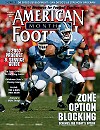AMERICAN FOOTBALL MONTHLY THE #1 RESOURCE FOR FOOTBALL COACHES
Article CategoriesAFM Magazine
|
Getting Everyone on the Same Page: Coach Ralph Munger Talks Aboutby: Jared Wood© More from this issue Preparing for the mental and emotional challenges of football can be confusing. How are coaches to know what works and what doesn’t? One way would be to ask successful coaches about how they prepare their teams. Another would be to learn about research in sport psychology. This article attempts to help you do both. Parts of my interview with my high school football coach, Ralph Munger, Head Coach of the Rockford High School Rams (2004 and 2005 Division 1 State Champions in Michigan), are presented here along with information about research-based theory in sport psychology. By presenting perspectives from coaching and psychology, I hope to get us all, “On the same page,” as Coach Munger often says. The Research on Confidence Most coaches agree that confidence is an important component of the mental ....The full article can only be seen by subscribers. Subscribe today!
|
|
|||||||
| HOME |
MAGAZINE |
SUBSCRIBE | ONLINE COLUMNISTS | COACHING VIDEOS |
Copyright 2025, AmericanFootballMonthly.com
All Rights Reserved





